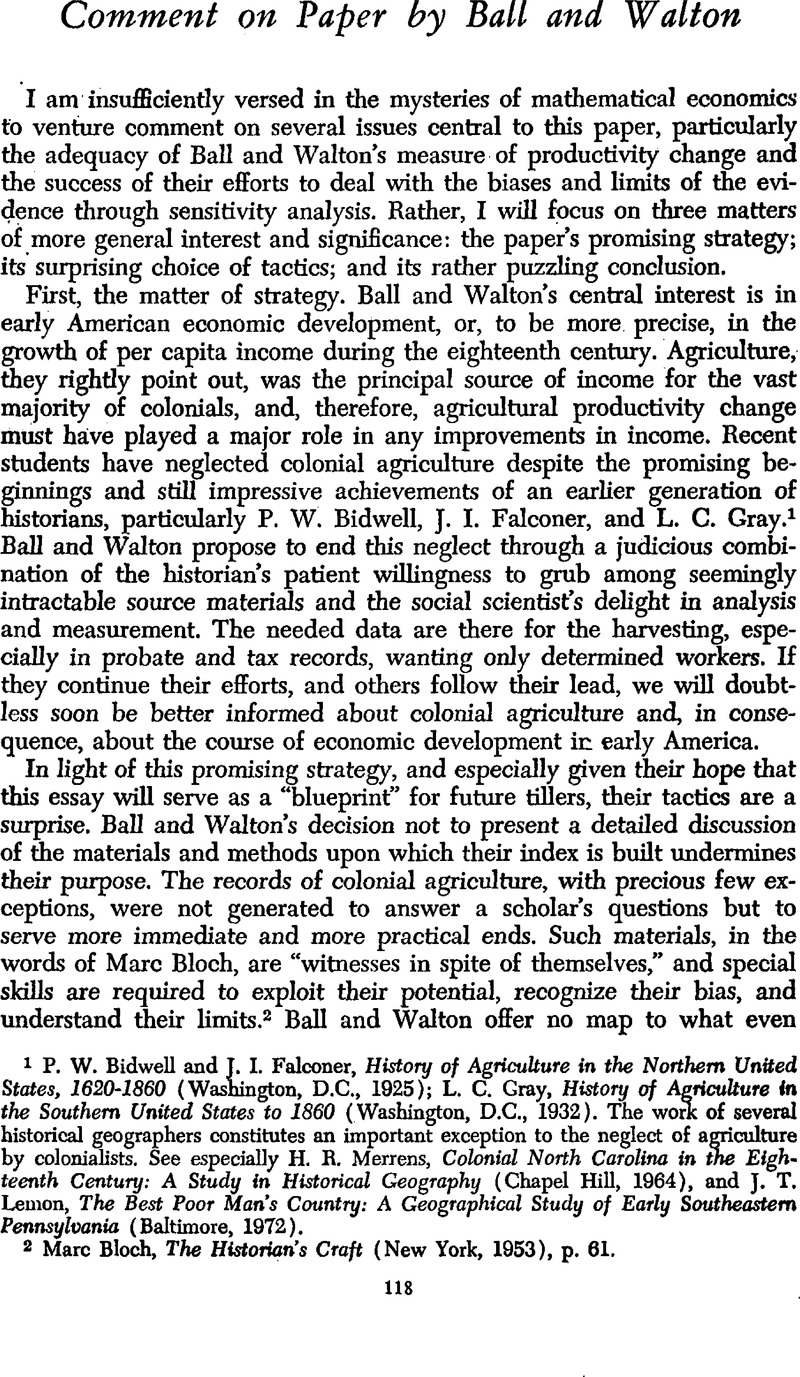Article contents
Comment on Paper by Ball and Walton
Published online by Cambridge University Press: 11 May 2010
Abstract

- Type
- Papers Presented at the Thirty-Fifth Annual Meeting of the Economic History Association
- Information
- Copyright
- Copyright © The Economic History Association 1976
References
1 Bidwell, P. W. and Falconer, J. I., History of Agriculture in the Northern United States, 1620–1860 (Washington, D.C., 1925)Google Scholar; Gray, L. C., History of Agriculture in the Southern United States to 1860 (Washington, D.C., 1932)Google Scholar. The work of several historical geographers constitutes an important exception to the neglect of agriculture by colonialists. See especially Merrens, H. R., Colonial North Carolina in the Eighteenth Century: A Study in Historical Geography (Chapel Hill, 1964)Google Scholar, and Lemon, J. T., The Best Poor Man's Country: A Geographical Study of Early Southeastern Pennsylvania (Baltimore, 1972)Google Scholar.
2 Bloch, Marc, The Historian's Craft (New York, 1953), p. 61Google Scholar.
3 Wells, Robert V., “Family Size and Fertility Control in Eighteenth-Century America: A Study of Quaker Families,” Population Studies:. A Journal of Demography, 25 (1971), 73–82Google Scholar; Idem, “Quaker Marriage Patterns in a Colonial Perspective,” William and Mary Quarterly, 29 (1972), 415–442Google Scholar.
4 Some support for these assumptions is found in Wells, “Family Size and Fertility Control.”
5 Three more points concerning the accuracy of the labor index deserve mention. First, the 50 percent mortality rate Ball and Walton apply to children may be too high and the assumption of a constant level of infant and childhood mortality across the eighteenth century unjustified. Second, calculations from the 1764 and 1791 tax lists are an inadequate base upon which to rest the assumption that the number of servants and slaves per farm was small and fairly constant during the entire eighteenth century. Given what is known about Pennsylvania immigration patterns, one would expect a sharp decline in the servant population beginning in the mid-1750's. See Lemon, Best Poor Man's Country, pp. 9–10, 236, note 41. In fact, a fragment of a 1759 assessor's return for Chester County printed in Nash, Gary B., ed., Class and Society in Early America (Englewood Cliffs, N.J., 1970), pp. 55–56Google Scholar, yields 1.6 to 2.4 as many servants as reported by Ball and Walton for 1764, depending upon how a farm is defined. The possibility of disagreement over precisely what constitutes a farm on a tax list is a good example of the type of issue that the authors ought to confront. Third, Ball and Walton admit that completed family size yields figures that in absolute terms are higher than mean number of children per family, but argue that changes in completed family size capture the trend in fertility and that the trend, rather than the absolute numbers, “is the important consideration for the index.” Even if completed family size were an adequate proxy for the trend, its use is still inappropriate: high numbers give children more weight in the labor index than they should have, thus making that index overly sensitive to changes in fertility.
6 For elaboration see Harris, P. M. G., “The Social Origins of American Leaders: The Demographic Foundations,” Perspectives in American History, 3 (1969); 159–344Google Scholar.
7 Shepherd, James F. and Walton, Gary M., Shipping, Maritime Trade, and the Economic Development of Colonial North America (London, 1972), p. 69Google Scholar.
8 Evidence for the timing of changes in shipping productivity during the seventeenth century is presented in Menard, Russell R., “Economy arid Society in Early Colonial Maryland” (Ph.D. Dissertation, University of Iowa, 1975), pp. 480–484Google Scholar. I will make the eighteenth century data available soon.
9 Note the similar rate uncovered by Marc Egnal from much different sources in “Economic Development in the American Colonies,” William and Mary Quarterly, 32 (1975), 199–200Google Scholar.
- 1
- Cited by


